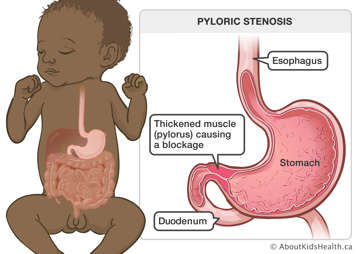What your child's health-care provider can do
Your baby's health-care provider will listen to your story and will examine your baby. If they suspect pyloric stenosis, they will order blood tests and an ultrasound. An ultrasound is the most common method of diagnosing pyloric stenosis.
Many babies with pyloric stenosis may be dehydrated and may have electrolyte imbalances in their blood due to vomiting. They will need intravenous (IV) fluids and will require their electrolytes to be corrected before surgery can be performed. They may have a tube inserted through their nose to their stomach to help empty the contents of the stomach. During this time, your child will not be allowed to eat.
Your child will remain hydrated with the IV fluids that they are receiving and blood work may be repeated to ensure their electrolytes are within acceptable ranges prior to proceeding with surgery. If your baby has pyloric stenosis, they will need a surgery called a pyloromyotomy. During a pyloromyotomy, the surgeon will cut the tight muscle between the stomach and the small intestine. This loosens the muscle so the stomach can empty. Food will then be able to pass easily into the small intestine.
For more information, please see the article: "Pyloromyotomy: Surgery for pyloric stenosis".
